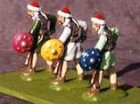Medieval Syrian 1100AD - 1286ADby Tony De Lyall Medieval Syrian - DBA Army #139 - The Options
The list covers the Muslim armies of the various Turkish and Arab Syrian cities and the Abbasid Khalifate of Baghdad after the break-up of the Seljuq Empire, and the Syrian Ayybids provinces after the death of Saladin. Background (courtesy of Stephen Monatgue) After the Seljuk Empire fell apart with Malik Shah's death in 1092 the Syrian cities became independent autonomous states. The cities were ruled by rival dynasties that were often openly hostile to one another. This lack of co-operation is cited by Sir Charles Oman as the reason for the First Crusade's success. According to WRG's DBM list Vol. 4 the cities were divided as follows-
Oman confirms Aleppo and Damascus. He also mentions Mosul and gives a list of the rulers. The most important city was undoubtedly Damascus; Aleppo was also of importance. All of the cities owed their secular allegiance to Baghdad though this was largely ignored. The spiritual allegiance was also to Baghdad. This state of affairs came to an end with the rise of Zengi (or Zangi). Zengi was a general of the Seljuk Sultan Mahmud. He was appointed ruler of Mosul in 1127. He took Aleppo in 1128 and by 1130 controlled Syria as far south as Homs. However a resurgent Byzantine Empire under John Comnenus held Zengi in check. The Byzantines had extended their control to include Cilicia and northern Syria. It was only after John's death in 1143 that Zengi was free to move again. In 1144 he successfully besieged Edessa. Zengi was murdered by a servant in 1146 and was succeeded by his son Nur ed-din. Zengi is credited with stopping the Crusaders in their tracks and creating the conditions for the eventual destruction of the Crusader states. Nur ed-din's conquests extended to Egypt. Upon his death his Egyptian agent Saladin set up on his own and soon absorbed the Zangid lands into his own Ayyubid sultanate. (The Ayyubids are subject to a different DBA army list. However the Medieval Syrian list covers the provincial Ayyubid dynasties of Syria after Saladin's death.) The Moslem cities not only fought each other but at times would ally themselves with the Crusaders. The following quote from Oman gives an interesting example of the confusing politics of the early Crusades - "The strange battle of Tel-Basher in 1108 is worth notice. Trancred of Antioch and Joscelin lord of Tel-Basher, had quarrelled. So had Ridwan of Aleppo and Javaly of Mosul. Each allied himself with a stranger against his co-religionist, and in the fight Frank fought with Frank, Turk with Turk. Tancred and Ridwan were victorious." Enemies Enemies are -> Seljuq Turkish (124), Cilcian Armenian (132), Comnenan Byzantine, (133), Early Crusader (138), Later Crusader (141), Khwarizmian (146), Mamluk Egyptian (158), Ilkhanid (159a) You would have to add to this list Medieval Syrian (139) to cover the disputes between the rival Syrian cities. Notes on the Figures The army is made up from -
Light Horse
These light cavalry horse archers come from straight from the Italeri Saracens set. You can see a conversion for a different style of Turkoman horse archer here. Bedouin wore a long wide sleave tunic (the Gubba)which covered the whole body down to the ground. They wore a turban warped around the head with one strip under the chin. Tunics were a variety of bright colours mainly shades of red and blue and could be striped. I can't think of any plastic figure sources will allow you to model Bedouins cavalry easily. Syrian Cavalry
Syrian cavalry seemed to have been armed with lance, sword and shield but usually not with a bow. Armour might consist of quilted al-Qutun garment and/or lamellar or mail or scale corsets. Several of the Italeri Mounted figures are suitable for Syrian Cavalry needing little or no conversion.. The figures shown here originally wielded a mace and have undergone a small conversion whereby the mace was cut off and replaced with a lance made from 0.8mm brass rod. They are mounted on converted HAT Prussian Uhlan horses. The figures themself closely resemble a drawing of a Ayyubid cavalryman from Mosul in Health's Armies and Enemies of the Crusades. Heath identifies the armour being worn as a Kuzaghand - a mail corset covered in quilted cloth and silk, with mail sleaves. Colours could be red, yellow brocade or embroided. I have painted the figure wearing metallic amour but a Kuzaghand would be colourful alternative. The helmet is common type being iron with a solid iron neckguard. Spear
DBM army lists classify the Ahdath as a Horde, although sometimes their ranks could be made up of ex-military men, and in Aleppo and Damascus they were the official maintainers of public order. My paint job and figures may be a little too uniform looking. However, there are several spear and pole armed figures in the Italeri set that together could be used to create a multi-coloured motley looking Ahdath. Auxilia
Psiloi
Notes on Painting You can go wild with the paints - brocade or bright silks being common with colours of dark or light blue, turquoise, brown, tan, red, green or black or indeed nearly any colour. Coats could also be highly decorated with geometric, floral or arabesque patterns but this is a bit beyond my painting ability. Shields are also colourful in white, yellow, red, blue, green, brown or black. References Barker, Phil. and Scott, Richard Bodley. DBM Army Lists, Book 3 & Book 4, 1994. (To contact the author, click here.) |




